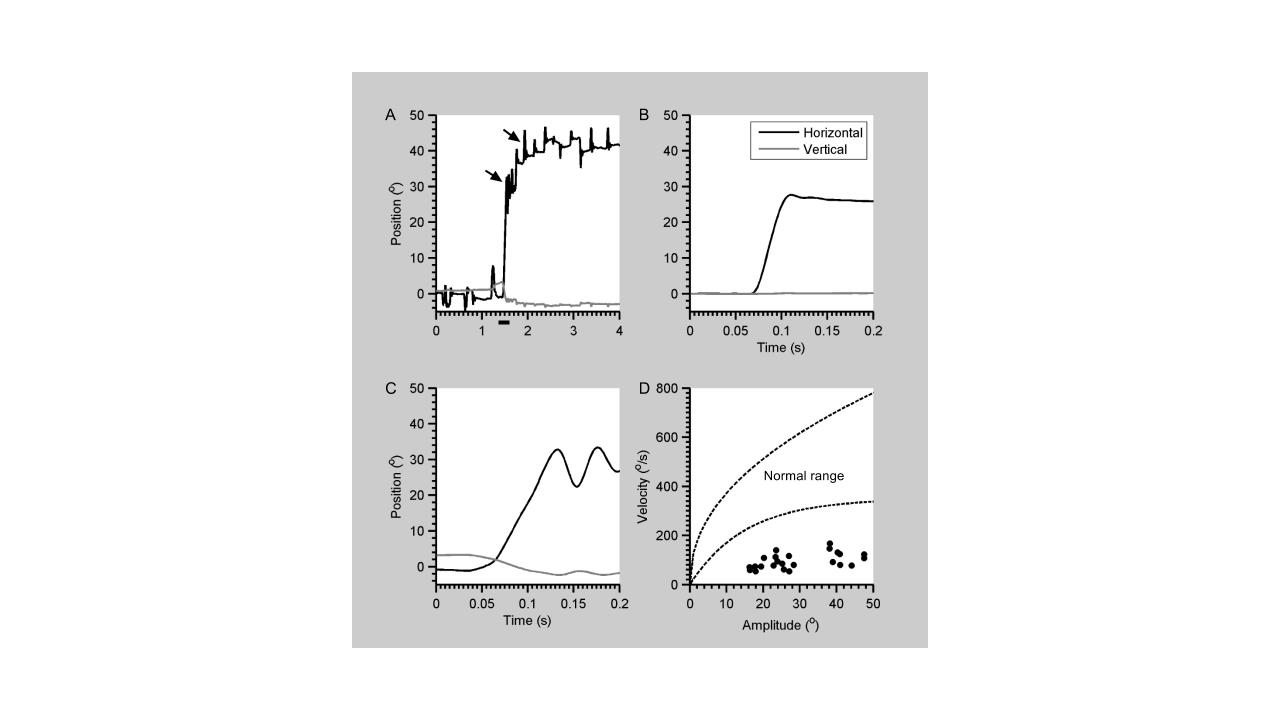Session Information
Date: Saturday, October 6, 2018
Session Title: Pathophysiology (Other Movement Disorders)
Session Time: 1:45pm-3:15pm
Location: Hall 3FG
Objective: We conceptualized a novel mechanism for seesaw nystagmus highlighting reverberations due to abnormal hyperexcitability of the reciprocally innervating circuit of excitatory burst neuron in the midbrain interstitial nucleus of Cajal (INC) that is normally inhibited by the cerebellum. A patient with ANNA-2 secondary to breast cancer had presented with both seesaw nystagmus and saccadic oscillations. We propose that hyperexcitability of the burst neurons in the interstitial nucleus of Cajal and reduced efficacy of cerebellar inhibition due to paraneoplastic antibody caused seesaw nystagmus. In addition, hyperexcitability of brainstem burst generators and reduced efficacy of omnipause neurons caused saccadic oscillations.
Background: The precise mechanism of saccadic oscillations is unknown but contemporary theory suggests that such oscillations can be attributed to a malfunction within the neurons of brainstem reticular formation that generate saccades by physiologic membrane properties and feedback connections (Shaikh 2007; Shaikh & Wong 2010).
Methods: A 49 year woman developed progressive oscillopsia over 2 months was found to have opsoclonus and torsional nystagmus. She was positive for ANNA-2. A biopsy confirmed small cell breast carcinoma with neuroendocrine features. We non-invasively measured two-dimensional eye movements to identify saccadic oscillations based on their distinctly separate clusters and high oscillation frequency. We also assessed cerebellar function by ocular motor test battery.
Results: Figure 1A depicts a visually guided horizontal saccade. Saccadic oscillations (arrow, Figure 1A), are seen before and after the saccade. Prior to initiation of saccade, the clusters of saccadic oscillations are less frequent, however, the clusters are more closely spaced temporally after the completion of saccade. Another result is saccade slowing.
Conclusions: This novel theory suggests the hyperexcitability of the INC excitatory burst neurons and reduced efficacy of cerebellar inhibition due to paraneoplastic antibody can cause seesaw nystagmus. The INC network lacks inhibitory reciprocal innervation. The consequence is lower frequency of pendular oscillations originating from the INC, while opsoclonus due to instability in brainstem burst neuron network has high frequency.
References: 1. Shaikh, Aasef G., Kenichiro Miura, Lance M. Optican, Stefano Ramat, R. John Leigh, and David S. Zee. 2007. “A New Familial Disease of Saccadic Oscillations and Limb Tremor Provides Clues to Mechanisms of Common Tremor Disorders.” Brain: A Journal of Neurology 130 (Pt 11):3020–31. https://doi.org/10.1093/brain/awm240. 2. Shaikh, Aasef G., Aaron L. Wong, Lance M. Optican, Kenichiro Miura, David Solomon, and David S. Zee. 2010. “Sustained Eye Closure Slows Saccades.” Vision Research 50 (17):1665–75. https://doi.org/10.1016/j.visres.2010.05.019.
To cite this abstract in AMA style:
M. Rizvi, L. Cameron, A. Shaikh, C. Kilbane. Unusual eye movement found in antineuronal nuclear autoantibody type 2 (ANNA-2); both seesaw nystagmus and opsoclonus may provide a novel mechanism [abstract]. Mov Disord. 2018; 33 (suppl 2). https://www.mdsabstracts.org/abstract/unusual-eye-movement-found-in-antineuronal-nuclear-autoantibody-type-2-anna-2-both-seesaw-nystagmus-and-opsoclonus-may-provide-a-novel-mechanism/. Accessed December 18, 2025.« Back to 2018 International Congress
MDS Abstracts - https://www.mdsabstracts.org/abstract/unusual-eye-movement-found-in-antineuronal-nuclear-autoantibody-type-2-anna-2-both-seesaw-nystagmus-and-opsoclonus-may-provide-a-novel-mechanism/

